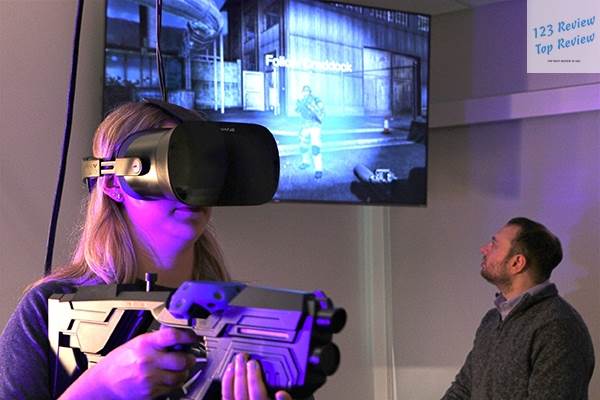In this article, 123 Review delves into the multifaceted impact of VR across different domains, exploring its benefits, challenges, and future potential with in-depth insights.
The Impact of Virtual Reality on Education
Benefits of Virtual Reality in Learning Environments
Virtual Reality (VR) is revolutionizing education by creating engaging, interactive learning experiences. It allows students to explore historical sites, conduct virtual science experiments, and visualize complex concepts, enhancing comprehension and retention. VR fosters active learning, critical thinking, and collaboration, making education more accessible and inclusive. For example, students can virtually visit the Roman Colosseum or explore the human circulatory system in 3D, making abstract concepts tangible and easier to understand. Additionally, VR can simulate real-world scenarios, such as emergency evacuation drills, providing practical experience in a controlled environment.

Case Studies of VR in Higher Education
Several universities in the US are pioneering the use of VR in their curricula, showcasing its diverse applications and benefits. Stanford University’s Virtual Human Interaction Lab, for instance, uses VR to study human behavior, allowing students to immerse themselves in virtual environments to observe and analyze social interactions. Similarly, the University of Maryland’s Immersive Media Design program integrates VR into creative courses, enabling students to create and interact with digital art in a virtual space. These case studies highlight how VR can enhance traditional learning methods, providing students with unique, hands-on experiences that would be impossible to achieve otherwise.
Challenges of Implementing VR in Schools
Despite its advantages, VR faces several challenges in educational settings. The high cost of VR equipment and software can be prohibitive for many schools, particularly those in underfunded districts. Limited technical expertise among educators and the need for curriculum integration are also significant barriers. Moreover, there is a learning curve associated with using VR technology effectively, which can deter its adoption. Ensuring equitable access to VR technology for all students, regardless of socioeconomic status, remains a critical concern. Additionally, the potential for motion sickness and other physical discomforts can pose challenges for widespread use.
Future Trends in Educational VR Technologies
The future of VR in education looks promising with advancements in technology and increased affordability. Trends such as augmented reality (AR) integration, AI-driven personalized learning experiences, and more immersive virtual environments are set to revolutionize education further. For instance, AR can overlay digital information onto the real world, enhancing the learning experience without isolating students from their physical environment. AI can tailor educational content to individual learning styles and paces, making learning more efficient and effective. As these technologies evolve, they will likely become more integrated into everyday learning environments, transforming how education is delivered.
VR Tools for Remote Learning
With the rise of remote learning, VR tools are becoming essential for creating virtual classrooms and interactive simulations. Platforms like ENGAGE and AltspaceVR provide virtual spaces for lectures, collaboration, and networking, bridging the gap between physical and remote learning environments. These tools offer features such as virtual whiteboards, 3D models, and interactive environments, allowing for a more engaging and interactive remote learning experience. They also enable students and teachers to interact in real time, fostering a sense of community and collaboration despite physical distances.
Virtual Reality in Healthcare
Applications of VR in Medical Training
VR is revolutionizing medical training by providing realistic simulations for surgical procedures, emergency response, and patient interactions. Platforms like Osso VR and SimX allow medical professionals to practice and hone their skills in a safe, controlled environment, improving patient outcomes. For example, surgical residents can perform virtual surgeries, receiving immediate feedback on their techniques without the risk of harming real patients. Emergency responders can simulate disaster scenarios, practicing their response strategies in a realistic but safe setting. These applications enhance the quality of medical training, ensuring that healthcare professionals are better prepared for real-world challenges.
VR for Patient Therapy and Rehabilitation
VR is also being used for patient therapy and rehabilitation, offering immersive environments for physical and cognitive therapy. Applications like MindMotion and VRPhysio help patients recover from injuries and manage chronic conditions through engaging, personalized treatment plans. For instance, stroke patients can perform rehabilitation exercises in a virtual environment, which can be more motivating and enjoyable than traditional methods. VR can also be used for cognitive therapy, helping patients with conditions such as PTSD or anxiety disorders confront and manage their symptoms in a controlled, therapeutic setting. These applications demonstrate how VR can enhance the effectiveness of therapy and rehabilitation, making it more engaging and effective for patients.
Ethical Considerations in VR Healthcare
The use of VR in healthcare raises several ethical concerns, including data privacy, informed consent, and the potential for addiction or overreliance on virtual experiences. Patient data collected during VR sessions must be securely stored and protected to prevent unauthorized access. Ensuring that patients fully understand and consent to the use of VR in their treatment is crucial. Additionally, there is a risk that patients may become overly reliant on VR for therapy, potentially neglecting other important aspects of their treatment. Addressing these issues is crucial for the responsible and ethical adoption of VR in medical settings.
Future Potential of VR in Medicine
The future of VR in medicine includes advancements in telemedicine, remote surgery, and personalized treatment plans. Telemedicine platforms can use VR to provide virtual consultations, allowing patients to interact with healthcare providers in a more immersive and engaging way. Remote surgery, where surgeons use VR to control robotic instruments, is another promising application, potentially allowing for complex surgeries to be performed across great distances. As technology evolves, VR has the potential to revolutionize patient care, making it more efficient, effective, and accessible. The integration of AI and machine learning with VR can further personalize treatment plans, tailoring therapies to individual patients’ needs and responses.
Case Studies of Successful VR Integration in Hospitals
Hospitals across the US are successfully integrating VR into their services, demonstrating its tangible benefits in healthcare. Cedars-Sinai Medical Center, for example, uses VR for pain management and patient education. Patients undergoing procedures can use VR to distract themselves and reduce their perception of pain, while educational VR experiences help patients understand their conditions and treatments better. The Mayo Clinic employs VR for surgical planning and training, allowing surgeons to practice and refine their techniques before performing real surgeries. These case studies highlight the diverse applications and significant benefits of VR in healthcare, showcasing its potential to enhance patient care and outcomes.
Virtual Reality and Entertainment
VR Technology in Gaming
VR has significantly impacted the gaming industry, offering immersive experiences that transport players into virtual worlds. Popular VR games like Beat Saber and Half-Life: Alyx showcase the potential of VR to revolutionize gaming, providing unparalleled interactivity and engagement. Players can physically move and interact with the game environment, creating a more immersive and engaging experience. The development of VR-specific hardware, such as motion controllers and haptic feedback devices, further enhances the gaming experience, making it more realistic and interactive.
Immersive Experiences in Film and Television
VR is also transforming film and television by offering immersive storytelling experiences. VR films and 360-degree videos allow viewers to explore scenes from different perspectives, creating a more engaging and interactive viewing experience. For example, VR documentaries can place viewers in the middle of a wildlife reserve or a historical event, providing a more immersive and educational experience. Filmmakers are exploring new ways to use VR to enhance storytelling, creating experiences that engage viewers in ways traditional media cannot.
The Role of VR in Live Events and Concerts
Live events and concerts are increasingly incorporating VR to offer virtual attendance and immersive experiences. Platforms like Wave and NextVR allow fans to attend concerts, sports events, and conferences virtually, enhancing accessibility and engagement. Fans can experience live performances as if they were there in person, with 360-degree views and interactive features that traditional broadcasts cannot offer. This technology also allows artists and event organizers to reach a global audience, breaking down geographical barriers and creating new opportunities for engagement.
Future Trends in Entertainment and VR
Future trends in VR entertainment include more sophisticated and interactive experiences, the integration of haptic feedback, and the development of social VR platforms. Haptic feedback technology, which provides tactile sensations, can enhance the realism of VR experiences, making them more immersive. Social VR platforms, where users can interact with each other in virtual environments, are also on the rise, creating new opportunities for socializing and collaboration. These advancements will further blur the lines between virtual and real-world experiences, creating new possibilities for entertainment and engagement.
Consumer Adoption of VR Entertainment
Consumer adoption of VR entertainment is growing, driven by the increasing availability of affordable VR headsets and diverse content offerings. Companies like Oculus, HTC, and Sony are producing more affordable and user-friendly VR devices, making the technology more accessible to a broader audience. As more high-quality content becomes available, from games to films to live events, consumer interest in VR is likely to continue to grow. As technology becomes more accessible, VR is set to become a mainstream entertainment medium, transforming how we experience media and entertainment.
The Business Potential of Virtual Reality
VR Applications in Real Estate
VR is transforming the real estate industry by offering virtual property tours and immersive walkthroughs. Potential buyers can explore properties remotely, saving time and resources while providing a more comprehensive view of the property. VR can also be used for architectural visualization, allowing architects and developers to create and showcase virtual models of buildings before they are constructed. This technology can enhance the buying and selling process, providing a more efficient and engaging experience for all parties involved.
Marketing and Advertising in the VR Space
Businesses are leveraging VR for innovative marketing and advertising campaigns. VR experiences create memorable brand interactions and allow consumers to engage with products in immersive environments. Companies like IKEA and Coca-Cola are using VR to enhance their marketing strategies, creating virtual showrooms and interactive experiences that engage consumers in new and exciting ways. VR can also be used for experiential marketing, allowing consumers to interact with brands in virtual environments that are more engaging and memorable than traditional advertising methods.
VR for Product Design and Prototyping
VR is streamlining product design and prototyping processes by enabling virtual modeling and testing. Industries like automotive and aerospace are using VR to visualize and refine designs, reducing development time and costs. For example, automotive manufacturers can create virtual prototypes of new vehicles, allowing designers and engineers to test and refine their designs before building physical prototypes. This can save time and resources, making the development process more efficient and cost-effective.
Case Studies of Businesses Leveraging VR
Several businesses in the US are successfully leveraging VR for various applications. For instance, Ford uses VR for vehicle design and testing, allowing designers to create and refine virtual prototypes before building physical models. This has significantly reduced development time and costs, enhancing the efficiency of the design process. Walmart employs VR for employee training programs, using virtual simulations to train employees in customer service, safety procedures, and other essential skills. These case studies highlight the diverse business potential of VR, showcasing how it can enhance efficiency, reduce costs, and improve outcomes across various industries.
Economic Impact of the VR Industry in the US
The VR industry is contributing significantly to the US economy, creating jobs and driving innovation. The development and production of VR hardware and software have created numerous job opportunities, from engineers and designers to marketers and sales professionals. The growing adoption of VR across various sectors, from healthcare to entertainment to real estate, is also driving demand for skilled professionals with expertise in VR technology. With continuous advancements and increasing adoption, the economic impact of VR is expected to grow, fostering new opportunities and driving economic growth.
Legal and Ethical Aspects of Virtual Reality
Privacy Concerns in VR Environments
Privacy concerns in VR environments include data security, user tracking, and the potential misuse of personal information. VR systems collect a significant amount of data, including biometric data, user behavior, and location information. Ensuring robust data protection measures and transparent privacy policies is essential to address these issues. Users must be informed about what data is being collected and how it is being used, and they must have control over their personal information. Implementing strong encryption and security measures can help protect user data from unauthorized access and breaches.
Regulations Governing VR Content and Usage
Regulations governing VR content and usage are still evolving. Establishing clear guidelines and standards for VR applications is crucial to ensure user safety, ethical practices, and compliance with legal requirements. This includes setting standards for content creation, ensuring that VR experiences are safe and non-harmful, and protecting intellectual property rights. Governments and regulatory bodies must work together to develop comprehensive regulations that address the unique challenges and opportunities of VR technology.
Ensuring User Safety in VR Experiences
User safety in VR experiences involves addressing issues such as motion sickness, physical injuries, and psychological effects. Motion sickness is a common issue in VR, caused by the disconnect between visual and physical movement. Developers must design VR experiences with user comfort in mind, incorporating techniques to minimize motion sickness. Physical injuries, such as tripping or bumping into objects, can be mitigated by creating safe, open spaces for VR use and implementing safety guidelines. Psychological effects, such as desensitization to violence or addiction, must also be considered, and appropriate measures should be taken to address these risks.
Intellectual Property Issues Related to VR
Intellectual property issues in VR include content ownership, copyright infringement, and the protection of creative works. As VR content becomes more prevalent, ensuring that creators’ rights are protected is crucial. This includes establishing clear legal frameworks for intellectual property in VR, protecting against unauthorized use and distribution of content, and ensuring that creators are fairly compensated for their work. Addressing these issues is essential to support innovation and creativity in the VR industry.
Future Legal Challenges in the VR Landscape
As VR technology evolves, new legal challenges are likely to emerge, including issues related to virtual property, digital identity, and jurisdiction in virtual environments. Virtual property, such as virtual real estate or digital assets, raises questions about ownership and rights. Digital identity, including avatars and virtual personas, presents challenges related to privacy, security, and identity theft. Jurisdiction in virtual environments, where users from different countries interact, raises complex legal issues about which laws apply and how disputes should be resolved. Proactively addressing these challenges will be essential to navigate the complex legal landscape of VR and ensure its responsible and ethical development.
In conclusion, Virtual Reality is poised to revolutionize various sectors in the United States, offering transformative benefits and presenting unique challenges. By embracing the potential of VR and addressing its ethical and legal implications, we can unlock new opportunities and enhance our experiences in education, healthcare, entertainment, business, and beyond. As VR technology continues to evolve, its impact on our lives is likely to grow, creating new possibilities and transforming how we learn, work, and play.





